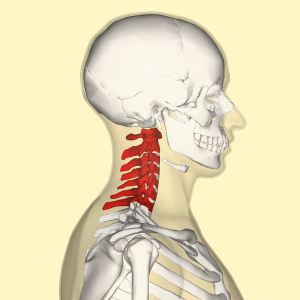The vertebral body is the large cylindrical bone towards the front of the vertebra. B contains transverse foramina.

Cervical Vertebrae C1 And C2 Cervical Vertebrae Vertebrae Skull Anatomy
B contains transverse foramina.

. Atlas and axis respectively. A large bony mass B. D has no body no spinous process.
The vertebral body carries most of the load for a vertebra. Which best describes a lumbar vertebra. At 90 degrees in the sagittal plane C.
In birds they are small and completely fused to the vertebrae. As they need to hold less weight they may be small in size when compared with thoracic and lumbar vertebrae. B does not contain transverse foramina.
At approximately 45 degrees anterior to the frontal plane D. A has a larger body than a thoracic vertebra b contains transverse foramina c body has articular surfaces called facets and demifacets d has no body no spinous process e has a peg-like process called a dens. 34 Which best describes the term scoliosis.
Which lower cervical vertebral body is the largest. Which of the following best describes the orientation of the facet joints in a typical functional segmental unit FSU of the cervical spine. There are 7 cervical vertebrae numbered 1 to 7 from above to downwards.
C body has articular surfaces called facets and demifacets. Check out these interactive spaced repetition-inspired quizzes. Each vertebra has a vertebral body arch and facet joint one on each side of the vertebra.
C body has articular surfaces called facets. C3-C7 are more classic vertebrae having a body pedicles laminae spinous processes and facet joints. Which best describes a typical cervical vertebra.
Posterolateral margin of the superior portion of the vertebral body. Cervical vertebrae C3 through C6 are known as typical vertebrae because they share the same basic characteristics with most of the vertebrae throughout the rest of the spine. 70 to 75 B.
A has a larger body than a thoracic vertebra. The cervical spine comprised of seven cervical vertebrae referred to as C1 to C7 is divided into two major segments. Quiz Cervical Vertebrae Anatomy C3 to C7 Want to save time learning vertebrae anatomy.
The CCJ includes the occiput and the two most cephalad cervical vertebrae known as the atlas C1 and the axis C2. E has a peg-like process called a dens. 33 Which best describes a typical cervical vertebra.
A column of bone supported by an intervertebral disk D. Where are the uncinate processes located on a typical lower cervical vertebra. The zygapophyseal joints for the typical cervical vertebra lie at an angle of ____ in relation to the midsagittal plane.
They are cylindrically shaped and are wider in the transverse than in the anteroposterior AP diameters. In sauropsid species the cervical vertebrae bear cervical ribs. Which of the following modifications would best demonstrate the lower cervical spine.
The vertebral transverse processes of. The size gradually increases from C3-7. A lateral bending of the vertebral column.
The craniocervical junction CCJ and the subaxial spine. C body has articular surfaces called demifacets. E has a peg-like process called a dens.
Repeat the exposure and increase kV. At approximately 25 degrees anteriro to the frontal plane. Which term best defines or describes the vertebral body of C1.
The third to 6th. This thick bone is cylindrical-shaped and located at the front of the vertebra. Cervical vertebrae are smaller than vertebrae in other regions.
22 Which best describes a typical cervical vertebra. Which term best describes the shape of a typical lumbar vertebral foramen. A has a bifid split into two parts spinous process.
18 Which of the bones listed below is part of the cranium. Which best describes the term scoliosis. In humans and almost all other mammals there are seven cervical vertebra which are labeled C1 to C7.
The body of a typical thoracic vertebrae. The first 2 C1 and C2 are highly specialized and are given unique names. The presence of foramen in their own transverse processes termed foramen transversarium the cardinal attribute of cervical vertebrae identifies them.
Cervical level three through six are considered typical cervical vertebra and are similar in shape and function. Typical Cervical Vertebrae. The smallest of all vertebral bodies C.
Which term best defines or describes the vertebral body of C1. The zygapophyseal joints for the typical cervical vertebra lie at an angle of ____ in relation to the midsagittal plane. The cervical vertebra are the smallest vertebra in the spine reflective of the fact that they support the least load.
In the transverse plane B. In lizards and saurischian dinosaurs the cervical ribs are large. In tetrapods cervical vertebrae are the vertebrae of the neck immediately below the skull.
15 Which best describes a typical cervical vertebra. A cervical vertebra is any of the vertebra in the cervical neck region of the spinal column. Truncal vertebrae lie caudal of cervical vertebrae.
D has no body and no spinous process. D processes are thick and short. C1 and C2 form a unique set of articulations that provide a great degree of mobility for the skull.

Cervical Vertebra Anterior View Cervical Vertebrae Vertebrae Skull And Bones


0 Comments